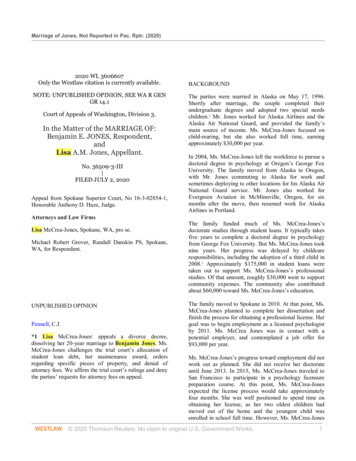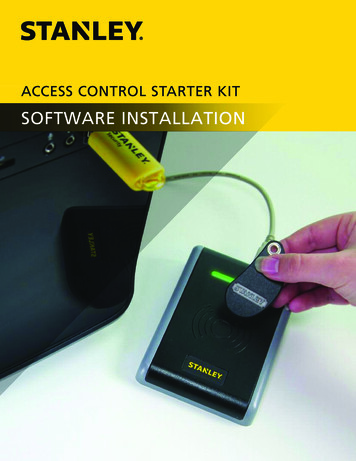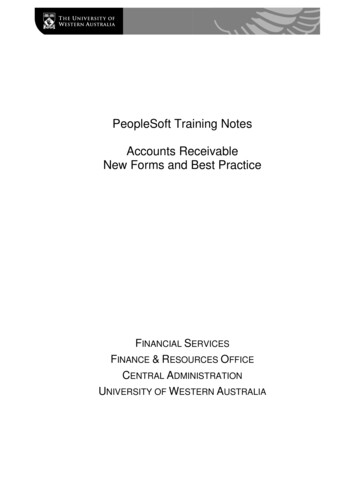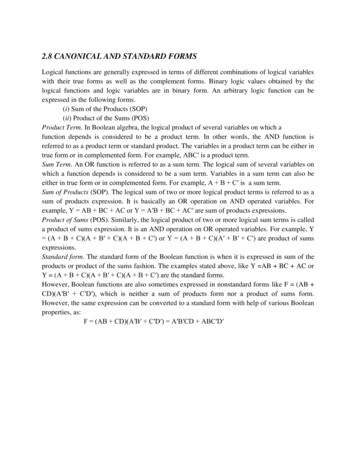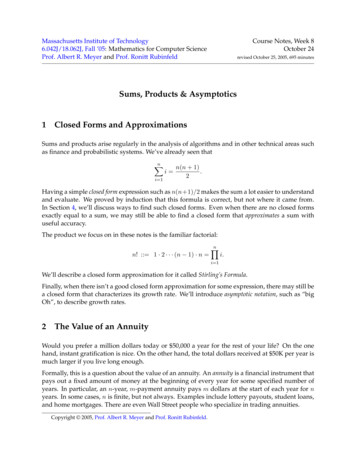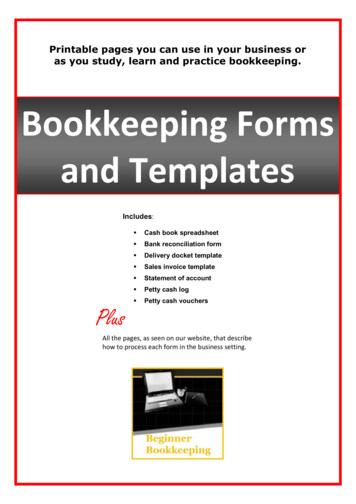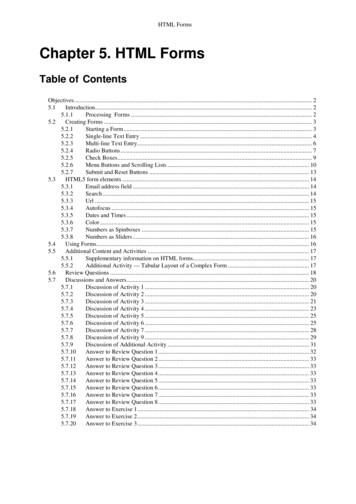
Transcription
AM-PAC Short Forms:Measuring Rehabilitation FunctionalOutcomes Across SettingsPresented by: Mary Slavin, PT, PhD, Director, Education and Dissemination,Health and Disability Research Institute; Boston University School of Public Health
About Mediware Rehabilitation and Respiratory Care Division25 years in business Specialists – Knowledge & Experience Acute, IRF, SNF, LTAC, HomeOutpatient RehabRespiratorySolution - PAC-MetrixTM Outcomes for All Levels of Care eCAT and short formsSolution – MediLinks ComplianceOutcomesRevenueEfficiencyChandler, AZ headquarters
License the AM-PAC Web-based AM-PAC One Assessment Instrument for Virtually Every Patient269 assessment questions to assess patients across almost every diagnosis and body part. One Instrument - Avoid confusion and mix-upsOne Score - Use it for metrics and comparisonsOne Workflow - Easier for the front desk and therapistsPaper Short Forms License the paper Short Forms to quickly and easily assess your patients3 separate versions (Standard Outpatient Short form, DOTPA (CMS) Outpatient Short FormInpatient “6-Clicks” Short Form)To see the AM-PAC in action, take a sample assessment for free.
Special Offer Thru April 15, 2014!!! 25% off PAC-Metrix AM-PACTM eCAT Licenses (first year)! Visit www.pac-metrix.com/ampac-ecat-sale/ Complete the form(The promo code AMPAC25% is included) Explain what you are trying to do or what you want to accomplish in the message box
Let’s Take a Quick Poll!
Activity Measure for Post-Acute Care(AM-PAC)TM Short FormsPresented by:Mary D. Slavin, PT, PhDDirector of Education and DisseminationHealth and Disability Research Institute Boston University2/27/2014
Learning Objectives Describe how the AM-PAC was developed.Understand the difference between short forms andcomputerized adaptive tests (CATs).List the different types of short forms available andidentify which form(s) is (are) most appropriate for agiven diagnosis or patient population.Describe procedures for reliable administration of theAM-PAC short forms and identify potential areas ofconcern regarding reliability.Discuss how to interpret AM-PAC short form scores anddescribe how to use scores to guide patient treatmentand quality improvement efforts.
Learning Objective1. Describe how the AM-PAC was developed.
Step 1. AM-PAC ItemsDeveloped items that assess important functionalactivities Incorporated items from existing instrumentsConducted focus group sessions with patients and theirfamilies to developed new itemsCognitively tested items – do people correctly interpretthe items?
AM-PAC developmentused the World HealthOrganization’sInternationalClassification ofFunctioning, Disabilityand Health (ICF) as aconceptual framework.
Step 2. Item Calibration StudyAdministered items to a large sample of persons witha wide range of functional abilities Calibration sample characteristics 1,041 patients in 4 different post-acute care settings: Outpatient Therapy (n 237)Home Health Care (n 246)Skilled Nursing or Transitional Care (n 138)Inpatient Rehabilitation (n 420)
Step 3. Identify Unidimensional Domains1Exploratory factor analysis of AM-PAC items Three distinct, interpretable factors identified andaccounted for 72% of the variance: Applied Cognitive (44%)Daily Activity (19%)Basic Mobility (9%);Confirmatory Factor Analysis verified 3 factors1HaleySM, Coster WJ, Andres PL, et al. Activity outcome measurement for postacute care. MedCare. 2004;42:I-49 –I-61.
Activity Measure for Post-acuteCare (AM-PAC) 269 itemsBasic Mobility131 itemsAmbulationDaily Activities88 itemsApplied Cognitive50 itemsFeedingCommunicationMeal PreparationPrint nsferBend, Carry, LiftLocomotionwith Device
Step 4. Item Response Theory (IRT)AnalysesCreate calibrated item banks for each domain Scale items in each domain hierarchy of difficulty Scaling assumptions met for each domain. Internal consistency reliability high for the totalsample (Cronbach alpha 0.92 to 0.94), and forspecific diagnostic groups (Cronbach alpha 0.90 to0.95).Scaling, residual factor, differential item functioning,and modified parallel analyses supported theunidimensionality and goodness of fit of each uniqueactivity domain
Step 5. Develop CATs and Short Forms Computerized Adaptive Tests (CATs)Computer program administers calibrated item banks Selects items based on response to previous items Items selected to match a person’s ability level Short Forms Items selected from the calibrated item banks to constructshort forms
Learning Objective2. Understand the difference between short forms andcomputerized adaptive tests (CATs).
AM-PAC Options AM-PAC e-CATComputer adaptive test Easy to input data and calculate scores Can be used across all care settings Requires access to program and computer AM-PAC Short Forms Does not require program or computerNeed different forms for inpatient and outpatient settingsAdministration Paper and pencilDevelop electronic system
Comparing CAT and Short Forms to ItemPools in the 3 DomainsHigh Correlation Between CAT and Score Estimates from theTotal Item Pool in Each DomainShort Form Scores provided good, but less consistent,estimates (especially in Applied Cognitive Domain), withlarger confidence intervalsAccurate Scoring of AM-PAC Domains is Possible with ShortForms and CAT applicationOverall, CAT provides a closer estimate with highercorrelation, but Short Forms still provide a good estimateReference: Haley SM, Coster WJ, Andres PL, et al. Score comparability of short formsand computerized adaptive testing: simulation study with the activity measure forpostacute care. Arch Phys Med Rehabil. 2004; 85:661–666.
All short forms include items calibrated on the same metric Scores from inpatient and outpatient short forms assesspatients’ function as they move from inpatient tooutpatient settings
AM-PAC Short Form Development Carefully selected items from the AM-PAC calibrateditem banks to develop short forms Inpatient (‘6-clicks’) Items are appropriate for inpatientsFunctional scores estimated with only 6 itemsOutpatient Generic (more high-level items)DOPTA (more low-level items, including use of wheelchair,developed for use in the Medicare population)
Short Form Development Process Involves careful selection of items from a scaled itembank for a specific domain based on 3 criteria:high information function (determined from IRT analysis) assess a range of functional ability (determined from IRTanalysis) represent relevant types of functioning (clinical judgment)
32Daily Activity Short Form Item Difficulty N 88Selected 6 Items for Inpatient; 15 Items for Outpatient10-1-2Inpatient-3Outpatient
AM-PAC Short Form Integrity Each AM-PAC short form was developed to meetspecific criteriaItems were carefully selected from the item banks Short form scoring is based on the items included in eachform Do NOT change or alter short form items
Learning Objective3. List the different types of short forms available andidentify which form(s) is (are) most appropriate for agiven diagnosis or patient ive
AM-PAC Inpatient “Six Clicks”Short FormsSix items, appropriate for the inpatient setting, wereselected from the calibrated AM-PAC item banks Measure functional ability in three domains: Basic MobilityDaily ActivityApplied Cognitive
AM-PAC ItemsAM-PAC Short Forms include two different types ofquestions and response options: Difficulty Items: “How much difficulty does the patient currentlyhave ”1 Unable2 A lot3 A little4 None Help from another person items: “How much help from anotherperson does the patient currently need ”1 Total2 A lot3 A little4 None
Examples: Inpatient Short Forms
UnableALotALittleNoneTurning over in bed (including adjusting bedclothes, sheets andblankets)?1234Sitting down on and standing up from a chair with arms (e.g.,wheelchair, bedside commode, etc.)1234Moving from lying on back to sitting on the side of the bed?1234TotalA LotALittleNoneMoving to and from a bed to a chair (including a wheelchair)?1234Need to walk in hospital room?1234Climbing 3-5 steps with a railing?1234How much difficulty does the patient currently have How much help from another person does the patient currentlyneed
How much help from another person does the patientcurrently need TotalA lotA Little NonePutting on and taking off regular lower body clothing?1234Bathing (including washing, rinsing, drying)?1234Toileting, which includes using toilet, bedpan or urinal?1234123412341234Putting on and taking off regular upper body clothing?Taking care of personal grooming such as brushing teeth?Eating meals?
How much difficulty does the patient currently have Following/understanding a 10 to 15 minute speech orpresentation (e.g., lesson at a place of worship, guestlecturer at a senior center)?Unable A Lot A Little None123412341234Remembering where things were placed or put away (e.g.,keys)?1234Remembering a list of 4 or 5 errands without writing itdown?12341234Understanding familiar people during ordinaryconversations?Remembering to take medications at the appropriate time?Taking care of complicated tasks like managing a checkingaccount or getting appliances fixed?
AM-PAC Short Forms:Outpatient SettingOutpatient Short Form Options:GenericMedicare Part B (DOTPA)
AM-PAC Outpatient Short FormsItems banks were reviewed and itemsappropriate for the outpatient setting, wereselected from the scaled AM-PAC item banksin three different domains Basic Mobility Daily Applied Cognitive
AM-PAC Item FormatAM-PAC Outpatient Short Forms use the followingresponse options: Difficulty Items: “How much difficulty do youcurrently have ”1. Unable2. A lot3. A little4. None
Example: Generic OutpatientShort Forms
How much difficulty do you currently have UnableA LotA LittleNoneBending over from a standing position to pick up a piece of clothing from the floorwithout holding onto anything?1234Standing up from a low, soft couch?1234Taking a 1-mile brisk walk, without stopping to rest?1234Running for 5 minutes on even surfaces?1234Walking several blocks?1234Walking up and down steep unpaved inclines (e.g., steep gravel driveway)?1234Running a short distance, such as to catch a bus?1234Carrying something in both arms while climbing a flight of stairs (e.g., laundry)?1234Going up and down a flight of stairs outside, without using a handrail?1234Making sharp turns when running fast?1234Taking part in strenuous activities (e.g., running 3 miles, swimming half mile, etc.)?1234Standing up from an armless straight chair (e.g., dining room chair)?123412341234Doing light housework (e.g., dusting, minor sweeping)?1234Moving up in bed (e.g., reposition self)?1234Getting into and out of a car/taxi (sedan)?1234Cleaning up spills on the floor with a mop?1234Walking on an uneven surface (e.g., grass, dirt road or sidewalk, brick walkways,sidewalks with curb and driveways cuts)?Walking around one floor of their home, taking into consideration thresholds,doors, furniture, and a variety of floor coverings?
UnableALotALittleNoneTying shoes?Sewing on button?11223344Pounding a nail in straight with a hammer to hang a picture?1234Unscrewing the lid off a previously unopened jar without using devices?1234Replacing or tightening small parts using only hands (e.g., screws)?1234Removing stiff plastic packaging using hands and scissors?1234Cutting toenails?1234Hanging wash on a line at eye level or above?1234Washing indoor windows?Moving a sofa to clean under it?11223344Holding a screw and screwing it tight with a manual screwdriver?1234Lifting 25 pounds from the ground to table height?1234Lifting 100 pounds or more?Doing 5 push-ups without stopping?112233441234How much difficulty do you currently have Managing clothing behind their back (belt loops, tucking in shirt, bra, etc.)?
How much difficulty do you currently have UnableA LotA LittleNoneUnderstanding familiar people during ordinary conversations?1234Making yourself understood to other people during ordinary conversations?1234Remembering things such as steps to complete daily activities, people's names, etc.?1234Making yourself understood to familiar people over the phone?1234Describing something that has happened to you so that others can understand you?1234Carrying on a conversation with a small group (e.g., family or a few friends)?1234Asking a stranger for information (e.g., asking a clerk where something is located in the store)?1234Requesting information or assistance from the person who answers the phone (e.g., Ask storehours, make an appointment, or notify someone about a problem)?1234Explaining how to do something involving several steps to another person?1234Managing your time to do most of your daily activities?Reading a long book (over 100 pages) over a number of days?Reading and following complex instructions (e.g., directions to operate a new appliance or for anew medication)112233441234Looking up a phone number or address in the phone book or in your own address book?1234Planning for and keeping appointments that are not part of your weekly routine (e.g., a therapy,doctor appointment, or a social gathering with friends and family)?1234Remembering to take medications at the appropriate time?Remembering where things were placed or put away (e.g., keys)?Remembering a list of 4 or 5 errands without writing it down?111222333444Taking care of complicated tasks like managing a checking account or getting appliances fixed?1234Keeping important personal papers such as bills, insurance documents and tax forms organized?1234
Example: Medicare OutpatientShort Forms
Medicare Outpatient Short Forms Developed to assess persons with lower level offunctioning, seen in outpatient settings Items at the lower end of the functional scale
License the AM-PA Web-based AM-PAC One Assessment Instrument for Virtually Every Patient 269 assessment questions to assess patients across almost every diagnosis and body part. One Instrument - Avoid confusion and mix-ups One Score - Use it for metrics and comparisons One Workflow - Easier for the front desk and therapists Paper Short Forms License the paper Short

